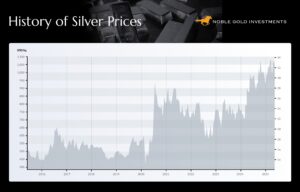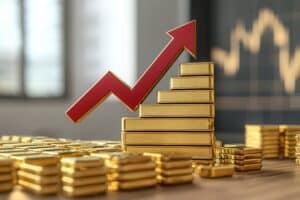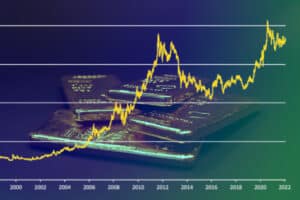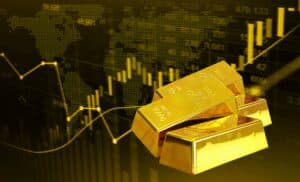Over eight millennia, silver value has evolved from ancient coinage to industrial material and one of the world’s most precious metals. The silver market’s breakthrough came when 16th-century explorers found a vast, entirely untapped supply of silver in what are now the countries of Peru and Bolivia. It quickly became a mainstay of the global economy.
Currently, you need about 90 ounces of silver to buy one ounce of gold. Throughout history, though, the gold-silver ratio has more often averaged around 50 or 60 to 1. Is there enough weight in historical silver prices that could point to silver’s power as a credible alternative asset?
We’ll take a closer look at the history of silver prices, the factors that drive silver value, and what silver’s evolution can show about its future potential.
Understanding the Fluctuations in Silver Prices
Although silver prices are currently a fraction of gold prices, the metal itself has an unusual edge. Both silver and gold are valued as safe-haven assets in times of economic volatility. However, physical silver has another role that distinguishes it from other precious metals.
Industrial Demand
While gold is more often used as an investment or in jewelry-making, silver is in higher industrial demand. Manufacturers use it to produce solar panels, electric vehicles, and electronic goods. The medical industry also uses silver products to develop new technology.
This dual purpose — as a financial instrument and an industrial resource — gives silver a utility that other precious metals don’t have.
With silver valued far below gold, its dual role as an industrial workhorse and investment asset subjects it to shifts in demand and investor sentiment. Industrial demand for silver changes according to typical market cycles. That makes the price of silver more susceptible to fluctuations than the price of gold.
Nevertheless, silver investment is used as a hedge against inflation, just like gold. At the same time, silver is heavily impacted by geopolitical events. Though it may seem bleak, times of conflict often drive the silver spot price higher due to its industrial use in defense and technology.
Central Bank Policies
Central bank policies regarding interest rates have a sizable impact on inflation, currency, and the appeal of precious metals. If the Federal Reserve keeps interest rates low, silver and gold become more attractive investments. Conversely, when rates go up to fight inflation, the appeal of precious metals drops at least temporarily, making investors more reticent to buy silver.
However, central banks tend to stockpile gold reserves for economic stability. They don’t do the same with silver. Swings in silver prices are driven more by industry demand and investor speculation.
Interest rate changes also impact the silver market. When rates are high, investors invest more heavily in stocks and bonds, so silver prices usually go down. But when rates are low, silver is more attractive to investors as a hedge against inflation, so its value increases.
Price of Silver History Chart

Historical Silver Price Milestones
A few specific events and conditions have had an outsized impact on the history of silver prices.
U.S. Coinage Act of 1873
Before 1873, the U.S. monetized silver and gold as legal tender. Silver bullion coins were in heavy circulation for everyday use, and the more valuable gold was accepted for pricier items. But as silver production grew disproportionately, its value fluctuated wildly. That triggered concerns that silver’s stability as a unit of currency could be in jeopardy.
The government passed the U.S. Coinage Act of 1873 to standardize the monetary system, ending the free coinage of silver. Other nations were moving to the gold standard thanks to its relatively stable value, and the U.S. followed suit.
The move proved controversial, as silver miners and indebted farmers claimed that the government favored wealthy gold investors instead of working-class Americans. When demand for silver decreased, its price fell sharply and remained depressed for years afterward.
The End of the Bretton Woods System
About 14 months before the official end of World War II, representatives of the 44 Allied nations convened in Bretton Woods, New Hampshire. The goal was to hammer out details of how the global financial system would be structured after the war ended.
Among other actions, countries agreed to stabilize currency rates by pegging them to U.S. dollars, which were based on the gold standard. Silver prices went down as the metal was no longer regarded as a central monetary source.
In the late 1960s, the U.S. was running up large trade deficits. The country was minting more U.S. dollars, but it didn’t have the gold reserves necessary to back their value, making foreign governments very nervous. In August 1971, President Richard Nixon announced that the U.S. would no longer convert the dollar into gold, eliminating the gold standard.
With the free flow of currency, trading of precious metals like silver and gold was permitted on open markets. Metal prices fluctuated wildly thanks to supply and demand, investor speculation, and the state of the global economy.
The Hunt Brothers and the Silver Spike
Nelson and William Hunt were two Texas oil barons with billions in net worth to their names. Toward the end of the 1970s, they decided to try to corner the silver market by buying up enormous quantities of the metal. This would, they surmised, send silver prices skyrocketing and generate them a handsome profit on the price spike.
The move partially accomplished what the Hunt brothers were after. Silver prices escalated to almost $50 USD per troy ounce, leaving investors and speculators in a state of panic. The Hunts’ actions also came to the attention of regulators and commodity exchanges, who were not pleased.
To shield everyday investors and avoid a market disruption, the Commodity Exchange (COMEX) placed stricter limits on silver futures trading. It raised the upfront cash requirement for buying silver contracts, making it more difficult to hold massive speculative positions.
The higher cost led many traders to unload their silver contracts, bursting the speculative bubble and driving silver prices down to $10 to $11 in just a few months. The spike was over.
Online Trading Platforms and ETFs
As the internet turned into a global force near the turn of the millennium, brokerages sought ways to give everyday retail investors more access to the trading market. This led to the development of online brokerages where investors could make real-time transactions themselves instead of through accountants or coin brokers.
Exchange-traded funds (ETFs) also came into fashion, grouping investments with similar characteristics into a single commodity that could be traded on the public stock exchange. These forces gave retail investors more direct access to silver, either as a direct investment or through silver-based ETFs.
In the 2008 financial crisis, frustrated investors began turning to silver ETFs and futures, which drove the price of silver higher again. Speculation again ran wild between 2010 and 2011, fueled by direct access and investor sentiment.
The Silver Spot Price: Calculation and Significance
The spot silver price is a key indicator that affects several aspects of the silver market, including silver bullion pricing, futures contracts, and industrial supply costs.
This number answers a very basic question: “If I wanted to buy a troy ounce of silver right now and receive the metal immediately, how much would it cost?”
How Is the Spot Silver Price Calculated?
The spot silver price is an interesting metric because it’s organically generated by active trading. It isn’t set by market regulators or other agencies. It is, however, heavily informed by two exchanges: COMEX in New York and the London Bullion Market Association (LBMA).
COMEX offers silver futures contracts, selling them throughout the trading day. Whatever contract is being traded most actively — generally the nearest-month future — acts as a kind of stand-in for silver’s current value. Meanwhile, in London, the LBMA oversees large, over-the-counter sales of silver and develops the LBMA Silver Price, which is informed by a daily electronic auction.
Finally, these signals are aggregated by financial data services and platforms. They’re buffered with metrics from the trading floor, including trading volume and demand for silver coins and bullion.
Forecasting Future Silver Price Trends
As with past generations, the direction of silver prices now and in the future hinges on its truly unique dual nature as an investment and industrial asset. If and when the green energy sector returns to the forefront (which may take some time), silver is sure to be in high demand. It’s a vital component in solar power and electric vehicles.
The historical price of silver reveals how the metal has always been somewhat volatile. In 2025, investors are most concerned about inflation and geopolitical uncertainty. The more welcome news is that silver prices have overcome overspeculation and macroeconomic doubts before.
Silver’s price may permanently remain in a state of flux. But New York financial analysts continue to have faith in the metal’s long-term prospects, especially if the technology and renewables sectors continue to thrive.
Will Silver Skyrocket Soon?
For silver to experience a surge in value, a few factors must come into play:
- Monetary Policy: Lower interest rates and stimulus packages can make silver an appealing investment
- Industrial Demand: Companies need silver for manufacturing and services, particularly green companies
- Inflation and Currency Strength: If inflation continues or the U.S. dollar declines, traders could consider silver as a hedge
- Supply Restrictions: Silver supply is slow to respond to price hikes since most of it is produced as a by-product of other mining activities
These forces all contribute to silver’s volatile price movements. They may go up, but they’re hard to time.
Evaluating Silver as an Investment
To understand silver’s investment potential, it’s important to analyze factors involving historical performance, market accessibility, and the form the product takes.
Historical Returns: Silver’s Performance Over the Last 20 Years
Over the last 20 years, silver has averaged around 8.4% in annual returns. That’s a slight edge of about 1% over gold’s average. Silver price fluctuations are often driven by industrial demand, or lack thereof.
The gold-silver ratio is a good resource for making timing decisions. The rise of silver ETFs has also increased the metal’s liquidity and accessibility in the marketplace.
The Role of Silver in a Diversified Portfolio
Investors can hold silver physically or “on paper.” Physical formats include bullion, coins, and bars. But today, 70% of all silver investment is held in ETFs since today’s investors are more concerned with liquidity and access.
Silver ETFs add instant diversification to your portfolio, which financial experts highly recommend. Physical silver offers tangible security, although storage can be a hassle. While paper silver investments are more convenient, many investors prefer not to entrust control of this asset to a third party.
Utilizing Silver Price Charts for Investment Decisions
Silver investors look at charts to determine price, momentum, and investor sentiment. These are some of the key metrics in silver price charts:
- Support and Resistance Levels: Price points where silver tends to bounce or stall
- Breakouts: Sudden moves going beyond support levels and below resistance levels
- Moving Averages: Such as the 50-day and 200-day moving averages
- Volume Spikes: Surges in trading volume that may confirm the strength of a move
- Trendlines: Pictorial representations of up-and-down trends
Some of the more popular platforms for accessing this data are Kitco, TradingView, and StockCharts. Online brokerages and bullion dealer sites may also have silver price charts for review.
Access the Silver Market With Noble Gold Investments
Noble Gold Investments gives everyday investors easy access to the precious metals markets. In addition to silver coinage markets, we help investors plan for the future with our innovative Silver IRA. We use our 20+ years of experience to build precious metal portfolios that are profitable and secure.
To learn more or set up an initial consultation, contact us online.







